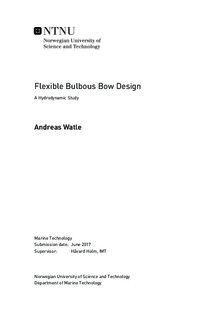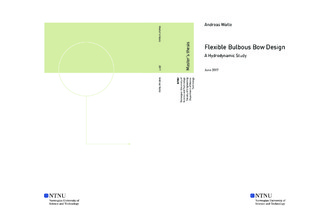| dc.description.abstract | With varying fuel costs and the pressure from International Maritime Organizations(IMO) Energy Efficient Design Index(EEDI) regulations regarding CO2 emissions, new economical and environmentally-friendly technologies are becoming an integral part of ship design. Vessels today face a broad spectrum of operating conditions, as they must take on a broad variety of trades, and one aspect of this is variation in sailing speed. The variation in operating conditions due to both long and short term effects in the global economy opens an untapped potential for further fuel savings, by introducing a flexible bulb that could adopt to the change in operating conditions in real time. This thesis aims to investigate the value of bulbous bows that can reconfigure the length during transit from a hydrodynamic point of view.
To fit merchant vessels with bulbous bows to reduce the total resistance of the hull is customary practice. Although the bulbs differ in terms of shape and size for the different vessel segments, the primary objective is to reduce the ships wave resistance, by generating a wave that interferes with the wave generated by the hull, resulting in a minimization the wave resistance. As ship owners have reacted to how ship speeds correlates to the state of the global economy, recent developments have been towards designing the bulb for a broader range of operating conditions. This design strategy is known as robust design, and is essentially suboptimal for each speed scenario. However, based on the variety of operating conditions ships are facing, the strategy is superior to optimizing the bulb for a fixed service speed. The introduction of the flexibility to the bulb design is an active method of creating value, contrasting the standard passive robust design approach.
Large scale effects such as the wave making of the vessel is mostly unaffected by viscous effects, and this supports the use of a potential flow code to evaluate the wave resistance of the hull. By evaluating the difference in wave resistance for the different length configurations of the flexible bulb, the potential of such a device can be stated. The potential flow code SHIPFLOW is used to rank the different bulb design modifications with respect to hydrodynamic performance.
The design procedure of the flexible bulbous bow is divided in two stages. The first stage is to analyze Automatic Identification System(AIS) data for a reference vessel to establish an applicable operating profile for the design model. The operating profile for the reference vessel ANL BAREGA was obtained from a study carried out in parallel, which has the objective of analyzing AIS data for the global fleet to identify the fuel savings from being able to reconfigure the bulb during transit. The second stage of the design cycle consists of an optimization procedure of the flexible bulb geometry, with respect to reduction in the weighted effective power over the operating profile.
The optimization of the flexible bulb configuration is a process which is divided into four separate parts. Firstly, the length, breadth and height parameters of the bulb geometry is parametrized with the use of parametric B-spline curves and surfaces. Parameterization with B-spline curves and surfaces hold the desired ability to morph the bulb geometry in an effective and efficient manner while retaining the typical bulb shape, with the movement of a set of control points on the bulb surface. The parameterization is derived and implemented within the workbench of the CAESES framework. The second part constitutes a search of the design space to identify the influence of the design parameters on the wave resistance for the various speeds in the operating profile. Furthermore, this part will establish a set of flexible bulb geometry candidates to be studied later in the optimization procedure. The third part of the optimization procedure is to establish a robust optimized bulb configuration with the use of a particle swarm optimization algorithm implemented in MATLAB. This bulb design will be used as reference for the flexible bulb, since it is industry standard. The last part consists of evaluating the flexible bulb candidates with a change in the length parameter. The performance of the flexible bulb configurations and the robust bulb configuration are compared establish the potential of flexibility in the bulb design.
To validate the design method and estimates the value of having a reconfigurable bulb, a case study on the KRISO container ship(KCS) coupled with the operating profile of the comparable container ship ANL BAREGA is presented. The results from the case study indicated a clear trend which states that the potential of flexibility in the bulb design is largely governed by the breadth parameter in the lower to mid speed regime, while in the higher speed regime the length parameter is the governing factor. As a result, the best flexible bulb configuration yielded a reduction in the weighted effective power of 0.22%. The reduction is too small to account for the assumed affiliated additional costs, leaving limited incentives for such a configuration to be implemented in ship design. | |

